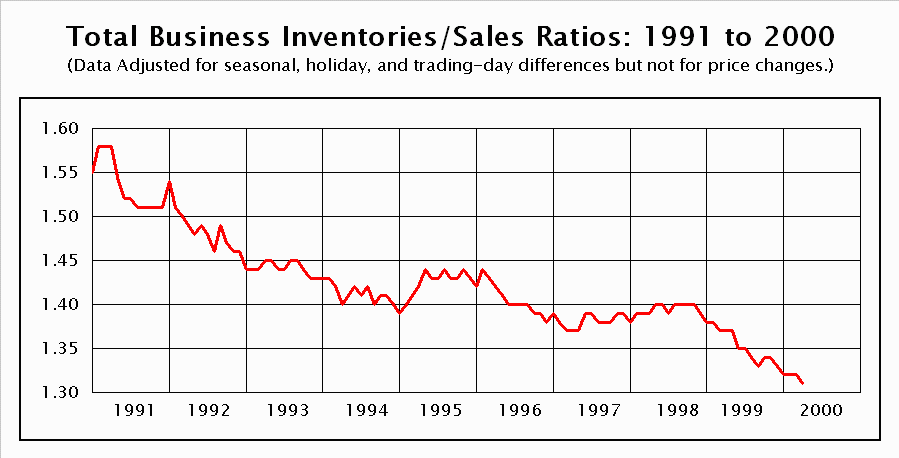Notice
of Revision. The adjusted and unadjusted monthly retail data were
revised based on the final results of the 1997 Census of Retail Trade and
the 1998 Annual Retail Trade Survey. The adjusted and unadjusted monthly
wholesale data were revised based on the final results of the 1997 Census
of Wholesale Trade and the 1998 Annual Trade Survey. Manufacturing data
were not revised.
Sales. The Census Bureau of the
Department of Commerce announced today that the combined value of
distributive trade sales and manufacturers’ shipments for March,
adjusted for seasonal and trading-day differences but not for price
changes, were estimated at $889.2 billion, up 1.2 percent (�0.2%) from
February and were up 9.8 percent (�0.4%) from March 1999. Total durable
goods were up 1.2 percent (�0.3%) from February and were up 8.4 percent (�0.5%)
from March 1999. Total nondurable goods were up 1.1 percent (�0.2%) from
February and were up 11.2 percent (�0.5%) from March 1999.
Inventories. Manufacturers’
and trade inventories, adjusted for seasonal variations but not for price
changes, were estimated at an end-of-month level of $1,164.8 billion, up
0.3 percent (�0.1%) from February and up 5.2 percent (�0.5%) from March
1999. Total durable goods were up 0.3 percent (�0.2%) from February and
were up 4.8 percent (�0.6%) from March 1999. Total nondurable goods
increased 0.4 percent (�0.1%) from February and were up 5.8 percent (�0.6%)
from March 1999.
Inventories/Sales Ratio. The
total business inventories/sales ratio based on seasonally adjusted data
at the end of March was 1.31. The March 1999 ratio was 1.37

The Manufacturing and Trade
Inventories and Sales Report for April is scheduled for release June 14,
2000 at 8:30 a.m. Questions concerning this report may be addressed to:
Nancy Piesto (301) 457-2706/2708 (Retail), Lee Wentela (301) 457-4832
(Manufacturing), or Scott Scheleur (301) 457-2747/2764 (Wholesale).
Electronic inquiries may be sent to: retail.trade@ccmail.census.gov.
The wholesale and manufacturing data in this
report also appear in the following monthly Census Bureau publications:
Current Industrial Reports (see M3 series for manufacturers data) and
Current Business Reports (see BW series for merchant wholesalers). Retail
data are available on the Census website at http://www.census.gov/mrts/www/mrts.html.
March data were released May 3 for manufacturers and May 9 for merchant
wholesalers. The data are also available the day of issue on the Internet
- http://www.census.gov/mtis/www/current.html - and on Department of
Commerce’s STAT-USA website; for information, call (202) 482-1986.
Table
1. Estimated Monthly Sales and Inventories for Manufacturers, Retailers,
and Merchant Wholesalers
(In millions of dollars)

See footnotes and notes at the end of table 3.
(p) Preliminary.
(r) Revised.
(s) Adjusted data were revised due to concurrent seasonal adjustment.
Table
2. Percent Changes for Sales and Inventories--Manufacturers, Retailers,
and Merchant Wholesalers

Table
3. Estimated Monthly Retail Sales, Inventories, and Inventories/Sales
Ratios, By Kind of Business
(In millions of dollars)

(p) Preliminary.
(r) Revised.
(s) Adjusted data were revised due to concurrent seasonal adjustment.
1 Inventories are on a non-LIFO basis
as of the end of the month.
2 Adjusted for seasonal variations and, in the case of sales,
for trading-day differences and holiday variations. Concurrent seasonal
adjustment is being used to adjust all sales, shipment, and inventory
estimates. Concurrent seasonal adjustment uses all available unadjusted
estimates as input to the X-12 program. The factors derived from the
program are applied to the current and previous month estimates and for
retail and wholesale estimates a year ago as well. For retail sales,
concurrent seasonal adjustment is also used to adjust the advance
estimates (published one month before the preliminary estimates) and the
estimates one year before the advance month. This explains the revision to
retail estimates from a year ago.
3 Manufacturers sales refers to the value of shipments by
manufacturers. The shipments data from individual manufacturers are
adjusted prior to tabulation for the number of trading days as well as for
any variations in the length of the reporting period.
Note: The Manufacturing and Trade Inventory and
Sales estimates are based on data from three surveys: the Monthly Retail
Trade Survey, the Monthly Wholesale Trade Survey, and the Manufacturers'
Shipments, Inventories, and Orders Survey. The sampling variability for
retailers and merchant wholesalers can be used to construct a 90 percent
confidence interval for the estimates. Over all possible samples, 90
percent of such intervals will cover the true estimate. These intervals
are given in parentheses for the estimates on the front page. If, for
example, the estimate is up 0.8 percent and the margin of sampling error
is because the manufacturer's mail panel is not a probability sample from
a known frame and standard errors of the industry estimates cannot be
calculated. Estimates from all three surveys are also subject to
nonsampling errors which can arise in any stage of the survey. Such errors
include coverage error (failure to accurately represent all population
units in the sample), response errors, coding errors, and nonresponse.
Although no direct measurement of these errors has been obtained,
precautionary steps were taken in all phases of the collection,
processing, and tabulation of the data to minimize their influence.
